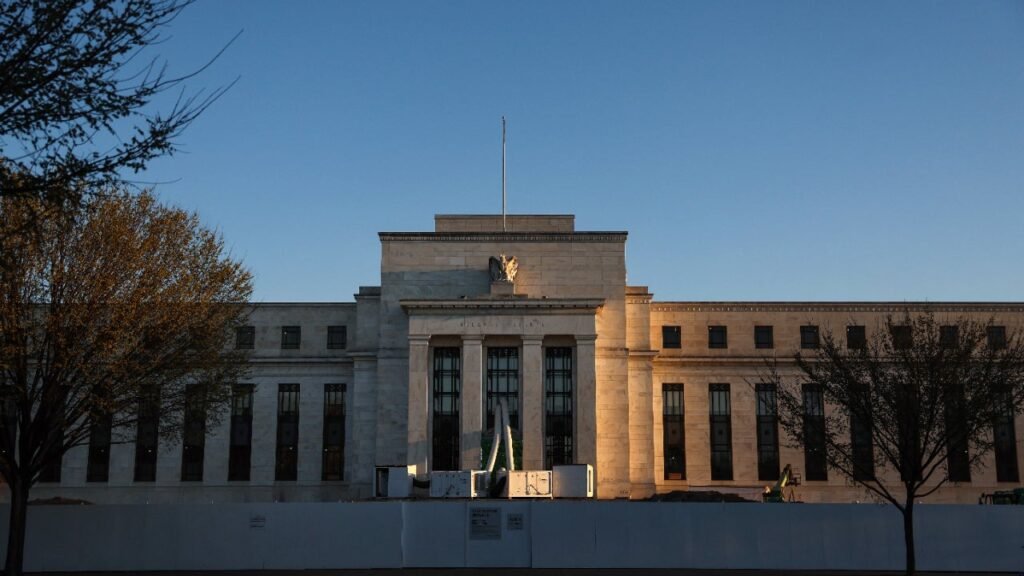The Federal Reserve has made important inroads in its battle in opposition to inflation, bringing it down to three.4 p.c in December. Though the central financial institution will not be fairly declaring victory but, its stance has change into extra dovish, and it maintained its goal rate of interest within the 5.25 p.c to five.50 p.c vary at its January 2024 assembly.
In a press launch indicating its rate of interest resolution, the Federal Open Market Committee, the Fed’s rate-setting physique, famous, “The Committee judges that the dangers to attaining its employment and inflation objectives are shifting into higher stability.” Nonetheless, it added, “The financial outlook is unsure, and the Committee stays extremely attentive to inflation dangers. In contemplating any changes to the goal vary for the federal funds fee, the Committee will rigorously assess incoming knowledge, the evolving outlook, and the stability of dangers. The Committee doesn’t count on will probably be acceptable to scale back the goal vary till it has gained better confidence that inflation is shifting sustainably towards 2 p.c.”
Based mostly on financial projections made by Federal Reserve members at their December assembly, the Fed is more likely to begin bringing down its goal fee in 2024. The trimmed imply projections of Fed members name for inflation within the 2.2 p.c to 2.5 p.c vary for 2024. That is down from their projections made earlier in September, once they noticed inflation working within the 2.3 p.c to 2.7 p.c vary for 2024.
Fed members additionally anticipate the unemployment fee might go as excessive because the 4.2 p.c vary for 2024, whereas beforehand that they had projected that it might rise to 4.4 p.c. The projections name for financial development within the 1.2 p.c to 1.7 p.c vary. This suggests that the financial system is more likely to keep away from an outright contraction and, as a substitute, obtain a mushy touchdown situation.
Fed stays vigilant about inflation, however probably achieved with fee raises
The Fed started a sequence of fee will increase in March 2022, when inflation was at 8.5 p.c, and has lifted up its goal fee from 0 p.c with a complete of 11 fee hikes by means of January 2024.
Despite the fact that these fee hikes have had the specified impact of bringing down costs, the Fed stays vigilant in its battle in opposition to inflation. In 2022, inflation — the rise in items and providers costs over a sustained time frame — was working at its highest degree in additional than 40 years. The Fed won’t be complacent till it’s satisfied it has slayed the beast.
In 1980, inflation below Fed Chair Paul A. Volcker reached 11 p.c. (At the moment, the Fed’s fee hikes pushed the financial system into recession, a situation that hasn’t materialized to date within the present fee hike cycle.) With that lesson in thoughts, the Fed is now centered on not bringing down its goal fee with out being sure that it has quelled inflation, so that customers and companies don’t anticipate greater inflation down the street.
Pandemic-related results led to inflation
The Fed’s sequence of fee hikes since March 2022 aimed to fight post-pandemic inflation. With provide chain disruptions and stimulus efforts supplied in the course of the pandemic, together with the affect of the warfare in Ukraine (which affected the value of oil and different commodities), stoking inflation, the Fed had been centered on elevating its focused rate of interest to fight the fallout from inflation that proved to be stickier than the central financial institution anticipated.
After the coronavirus pandemic started in 2020, the Federal Reserve initiated cuts that introduced down its goal rate of interest to virtually 0 p.c. That low fee was aimed toward spurring consumption and enterprise funding as a way to hold the financial system’s wheels greased because it recovered from the disaster.
The Fed additionally stepped in to buy mortgage-backed securities and Treasury securities, which, too, had the impact of pumping cash into the financial system and reducing rates of interest. It took extra measures as properly to forestall monetary markets from freezing up.
Now, in what is called quantitative tightening, the Fed can also be progressively shedding its stability sheet of the securities it acquired. This motion will suck up cash from the financial system and additional help the Fed’s agenda by pushing up rates of interest as a result of decreased cash provide.
Employment and inflation objectives
The Fed’s actions are guided by its twin mandate of managing each employment and inflation to optimize financial efficiency. Its goal is to shoot for optimum employment whereas letting inflation run at 2 p.c in the long term, making for value stability.
Again in 2020, the Fed determined it could hold charges low — at the same time as employment rose — to make the labor market extra inclusive and permit even deprived teams to get jobs, holding in thoughts the teachings realized after the 2008 recession, when inflation didn’t rise though employment continued to develop. It appeared the Fed wouldn’t begin elevating charges till 2023, however as inflation issues surfaced, the central financial institution began its tightening cycle earlier in March 2022.
Contemplating that the pandemic-influenced inflation continues to linger and was additional fueled by the warfare in Ukraine, the Fed is now centered on bringing inflation down in order that expectations for greater inflation don’t get entrenched within the minds of shoppers and companies. The Hamas assault on Israel in October has additionally heightened geopolitical stress.
Additional, though rising rates of interest have introduced down inflation, the labor market stays sturdy. Employers added 216,000 jobs in December, whereas the unemployment fee remained at 3.7 p.c. Common hourly earnings had been up 4.1 p.c over the 12 months. Nonetheless, the federal government revised down jobs numbers for October and November, which implies 71,000 fewer jobs had been added in these two months collectively than beforehand reported.
Customers anticipate decreased inflation
On the inflation entrance, it appears shoppers will not be wedded to the concept present excessive inflation ranges will stick. A College of Michigan survey finds that in January, shoppers anticipated inflation to be at 2.9 p.c within the 12 months forward, down from an expectation of three.1 p.c in December. That is the bottom degree in three years for shoppers’ inflation expectations within the year-ahead interval.
In a mid-January speech at The Brookings Establishment, Christopher J. Waller, a Fed governor, noticed that he’s assured that Fed is on the way in which to hitting its 2 p.c aim on inflation. He will probably be awaiting extra enchancment on the inflation entrance, along with some slowdown within the labor market that doesn’t harm the financial system. He mentioned, “So long as inflation doesn’t rebound and keep elevated, I consider the FOMC will be capable to decrease the goal vary for the federal funds fee this 12 months.”
When the Fed believes the time is correct to start out bringing down its goal fee, he expects will probably be achieved in a methodical method. In earlier financial cycles, the Fed’s fee cuts had been reactive and aimed to forestall a recession following shocks to the financial system.
Waller famous, “This cycle, nonetheless, with financial exercise and labor markets in good condition and inflation coming down progressively to 2 p.c, I see no motive to maneuver as rapidly or minimize as quickly as prior to now. The wholesome state of the financial system gives the flexibleness to decrease the (nominal) coverage fee to maintain the actual coverage fee at an acceptable degree of tightness.”
Influence on bank card rates of interest
What all of this implies for cardholders is that you’re more likely to see your variable card rates of interest stay at present excessive ranges for some time. Your card charges are tied to the prime fee, to which issuers add a markup to reach at your card’s rate of interest. The prime fee, in flip, relies on the Fed’s goal rate of interest. Because of this when the Fed begins mountaineering its goal fee, the prime fee additionally goes up.
And when the prime fee goes up, variable rates of interest quickly observe. Actually, rates of interest on bank cards have been shifting up over the past two years, with the nationwide common APR at 20.74 p.c in late January, up from 16.34 p.c in March 2022.
Meaning you must begin managing your bank card balances extra strategically. If you happen to carry a stability, make plans to pay it off. If you can be carrying a stability for some time, you would switch it to lower-interest choices, comparable to a stability switch bank card with a 0 p.c intro APR.
You may also think about taking out a private mortgage to repay your bank card if that gives a greater deal for you. Residence costs have been on a tear in recent times, and householders might even weigh getting a home-equity mortgage to repay bank card debt. Another choice can be to tackle a facet gig to earn extra earnings to repay your debt.
The underside line
Whereas the Fed maintained its goal fee within the 5.25 p.c to five.50 p.c vary at its January 2024 assembly, the central financial institution hasn’t but declared victory in its battle in opposition to inflation. Nonetheless, it appears the Fed is finished elevating its goal fee on this cycle and is more likely to begin bringing it down later in 2024.
Since variable bank card rates of interest are tied to the prime fee, which relies on the federal funds fee, shoppers needs to be ready for his or her variable rates of interest to proceed to stay at present excessive ranges for a while. Meaning you must take strategic motion for those who carry bank card balances so that you just pay the bottom rate of interest you qualify for.



